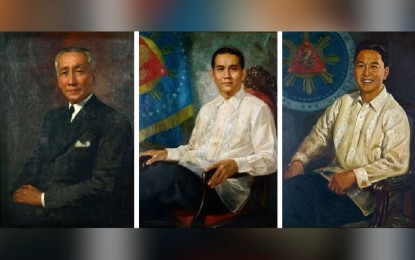
Former presidents Sergio S. Osmeña Sr. (1944-1946), Diosdado P. Macapagal (1961-1965), and Ferdinand E. Marcos (1965 to Feb. 25, 1986)
MANILA – Not many millennial Filipinos may be aware that of the 16 Philippine presidents from 1898 to the present, three were born in September and one of them died exactly on the birthday of his immediate predecessor.
Yes, the September-born former presidents were Sergio S. Osmeña Sr. (1944-1946), Diosdado P. Macapagal (1961-1965), and Ferdinand E. Marcos (1965 to Feb. 25, 1986).
Osmeña was vice president to Philippine Commonwealth President Manuel L. Quezon from 1935 to 1944.
He was catapulted to the presidency after Quezon died while he was in the United States on Aug. 1, 1944.
Born in Cebu on Sept. 9, 1878, Osmeña was the father of former senator Sergio Osmeña Jr., who challenged but failed to stop the reelection of President Marcos to a second term in 1969.
The elder Osmeña died on Oct. 19, 1961.
Macapagal, the ninth president of the Philippines, was born in Lubao, Pampanga on Sept. 28, 1910. He was elected to the country's top post in November 1961.
Before this, Macapagal served as vice president to President Carlos P. Garcia from 1957 to 1961. He ran for reelection in the 1965 polls but lost to Marcos.
Macapagal also served at the House of Representatives and headed the 1970 Constitutional Convention that drafted the 1973 Constitution. He was the father of former President Gloria Macapagal-Arroyo, who also became vice president, senator, and House speaker.
Macapagal died on April 21, 1997.
Marcos, the 10th president of the country, was born in Sarrat, Ilocos Norte on Sept. 11, 1917.
After serving as Senate president, he challenged the reelection bid of President Macapagal and won in the November 1965 elections.
Marcos was reelected to a second term in 1969.
A year before the supposed 1973 polls, he placed the entire country under martial law, abolished both chambers of Congress, and ruled by presidential decrees.
After announcing the lifting of martial law in 1981, Marcos called for a presidential election where he again won over former National Defense Minister Alejo Santos.
In November 1985, he announced he was calling for a snap presidential election to prove that he remained popular with the Filipino people.
The election, held on Feb. 7, 1986, pitted the Kilusang Bagong Lipunan (KBL) standard-bearers President Marcos and former Senate President and Foreign Minister Arturo M. Tolentino against the United Opposition's team of Mrs. Corazon C. Aquino, widow of assassinated opposition former senator Benigno "Ninoy" Aquino Jr., and former senator Salvador "Doy" Laurel.
The result of the highly contested election generated a nationwide controversy, with both sides accusing each other of cheating and resorting to other fraudulent acts.
The controversy eventually developed into people's rallies and demonstrations, which culminated in the historic and peaceful February 1986 EDSA People Power Revolution that ended the 20-year rule of Marcos.
Dubbed as the people’s revolt, aided by soldiers who rebelled against the Marcos government, on Feb. 22 to 25, 1986, it drove Marcos and his family out of Malacañang to Hawaii, where he died on Sept. 28, 1989, at age 72.
Ironically, the death of Marcos occurred exactly on the 79th birthday of former President Macapagal, his immediate predecessor.
The ruling administration of President Corazon C. Aquino refused to allow the repatriation of Marcos' remains to the Philippines.
It was only during the succeeding administration of President Fidel V. Ramos that the body of Marcos was brought back to Manila in 1993 and kept for several years at a refrigerated crypt in his home province of Ilocos Norte.
After President Rodrigo R. Duterte assumed office on June 30, 2016, he allowed the burial of Marcos’ remains at the Libingan ng mga Bayani (Heroes’ Cemetery) in Taguig City on November 18 that year.
The interment took place despite strong opposition from supporters and sympathizers of the Aquino family, as well as the so-called victims of martial law that Marcos imposed on Sept. 21, 1972 to prolong his rule, which began on Dec. 30, 1965.
The Supreme Court, voting 10-5, earlier allowed Marcos’ burial at the Libingan ng mga Bayani. (PNA)
